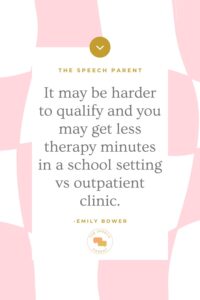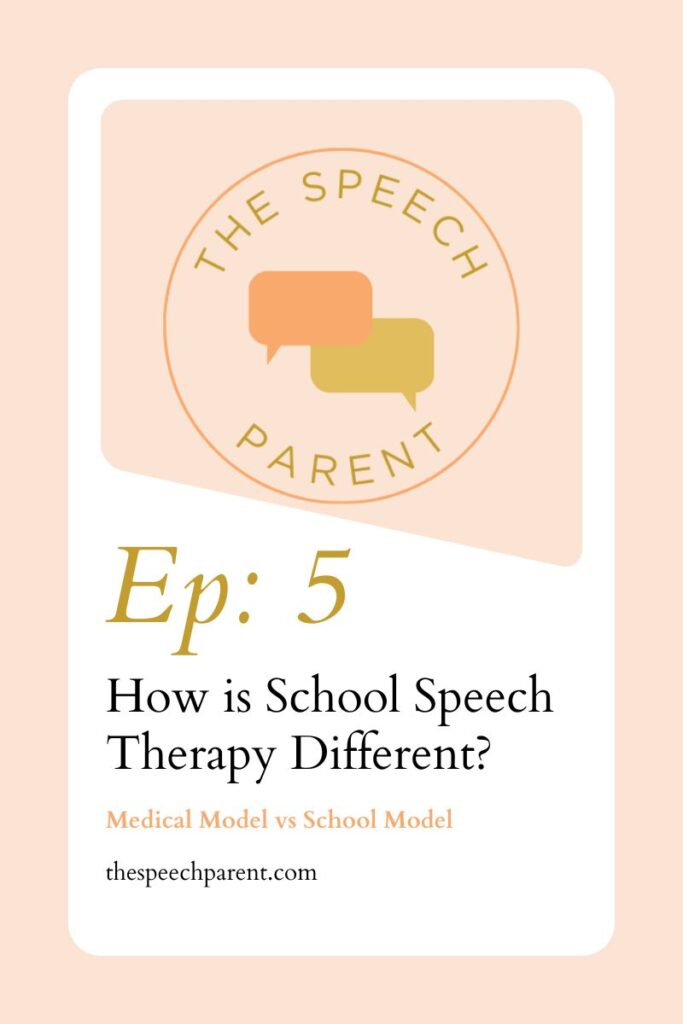Hello everyone and welcome back to (reading) the 5th episode of The Speech Parent. Today I’m answering the question: “How is School Speech Therapy Different?” I’m Emily Bower, and I’m so glad you’re here. If you’re a parent (or caregiver) of a child with a speech language delay – you’re in the right place! For the next two weeks we are talking all about speech therapy. Specifically, the difference between private, clinic-based therapy and therapy given in the school setting. I get asked the question about the difference between the two settings a lot. I thought it would be important to discuss.
If you have other questions that you want me to answer on the show, don’t forget that you can find me on social media. Go to @thespeechparent and send me a DM with your question, or you can email me at thespeechparent@gmail.com!
How is School Speech Therapy Different?
So today we’re exploring the difference between school speech therapy vs private therapy. By private therapy I mean what you would get at an outpatient clinic. Where you bring your kid to therapy and its usually one-on-one with a therapist vs happening while they’re at school.
There are some settings that are kind of a hybrid of the two. Like where I used to work. They have them in lots of places but it is a developmental preschool (so school setting) and also has an outpatient clinic. We work under the medical model of speech therapy. And really, that’s the big difference – the education model vs the medical model of speech therapy.
What’s the Education Model of School Speech Therapy?
So the education model is what is used in traditional public school systems. And the biggest difference is that in order to receive therapy, you must be able to prove that there is an adverse effect present. That the delay is impacting their access to education. This can get tricky because that’s a lot of gray area.
What exactly counts as an adverse effect? Well that usually depends on the school system’s special education program. Ultimately it should depend on the IEP (or Individualized Education Program) team. I’ll do future episodes on what an IEP is. Basically it’s the plan of action stating what services and accommodations the district is going to provide for your child based on their disability and individual needs.
So back to adverse effect. The IEP should have a component in it that states what that adverse effect is that is justifying services. You have to prove why the school district should ultimately pay for your child to get speech therapy. Some people interpret this very specifically, like they will only work on the exact articulation sounds the student has trouble with AND they’re spelling wrong as a result. Other people, like myself, interpret this more broadly. I see articulation errors in general as negatively impacting a student’s ability to communicate their thoughts and ideas clearly. This obviously impacts their learning greatly.

Not only is it harder to qualify for services on the school model, but you will also likely be recommended less minutes than in the medical model. Partially because they don’t want to remove you from class or take away the main objective of your classroom instruction ….and partially because school speech therapists are overworked and underpaid (like teachers) with massive caseloads that they just can’t handle it all.
Your kid may get group therapy 2 times a week for 30 minutes each or maybe just 1x a month for 30 minutes pushed into the classroom. It really should be determined based on what the child needs, but it’s hard for an IEP team to decide how much it’s worth it to remove the student from whatever is going on in the classroom to get therapy.
What’s the Medical Model of Speech Therapy?
On the flip side, in the medical model qualifying for therapy is usually just a matter of insurance qualifications or just the therapist’s clinical judgment if it’s private pay. It’s best practice to still explain in a qualifying report how the speech-language delay can impact the child’s ability to participate in activities of daily living such as talking to medical professionals or making friends.
But in general, you’re more likely to qualify with this model and more likely to be recommended a greater number of service minutes such as 3 times a week for hour sessions at 180 minutes of individual therapy weekly. Then again, a lot of times kids don’t really need that much therapy to make progress. It just depends!
Another thing that separates the two models of therapy is cost. Because of the Individuals with Disabilities in Education Act (or IDEA) school speech therapy should be free. It’s part of the requirement that all students should receive a free (AND APPROPRIATE) public education. The school may have therapists bill insurance in order to provide reimbursement, but ultimately the services have to be provided if they’re needed regardless of cost. But on the medical model, it has to be paid for either by insurance or private pay. If you can’t pay then you (generally speaking) can’t stay. As a result, a lot of kids can only access speech-language therapy in the school model.
IDEA offers School Based Therapy for Birth-21
So does this mean they can’t receive anything until they’re in kindergarten? Nope! IDEA part B includes ages 3 and up into the requirement for schools to serve. In addition, IDEA part C establishes an early intervention program for ages birth through 3.
If you have a child ages 3 and up – contact your local public school about services. If you have a child under 3, I’ve compiled a list of each state’s early intervention program name with links to their website and phone number. You can go to thespeechparent.com/state to find your state. That’s THEspeechparent.com/state
And if your child is in private school, the IDEA still covers them too!
So in general, therapy itself should look fairly similar between the medical model vs the school model. The goals may look slightly different but often even in the medical model therapists want goals that will improve communication skills for children in their daily lives, which includes some version of school.
Private clinics have a reputation of being more play based than schools, but really that’s more of an age factor as I played a lot of games with my school age kids and played with a lot of toys with my younger clients. Therapy does look different when it’s group vs individual, but you can find either version in any setting even though group therapy is most commonly used in the schools.
–
Now next week we’re going to dive even deeper into this topic by looking at the pros and cons of private therapy vs school speech therapy. If this is something you’ve been curious about, then you don’t want to miss it. Follow TheSpeechParent podcast on Spotify or Apple Podcasts so that you get alerted when new episodes drop each week.
And don’t forget that you can always ask general questions related to speech language delays or therapy by sending me a DM on social media @thespeechparent, emailing me at thespeechparent@gmail.com or joining our Facebook community to get insights from other parents just like you.
And if you have a specific question about your child that requires me to learn more about your unique situation, you can book a coaching call by going to thespeechparent.com/coaching
Thanks for reading the fifth episode of The Speech Parent podcast. Your support means the world to me and I’d love for you to leave a comment and share this blog with any of your friends who are looking for a community like ours. Let me remind you that you are doing great through all the highs and lows of this unique parenting journey. You are not alone, and I’m so glad you’re here. Remember – the best is yet to come. See ya next time
